HOME ON LEAVE from Scotland - Sept. 1944
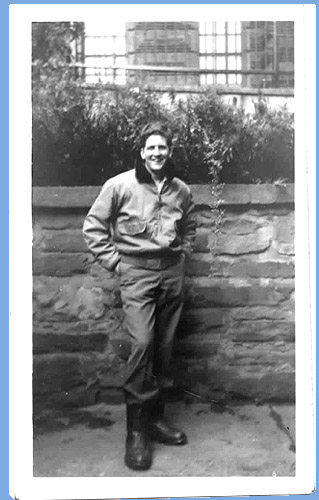
HOME ON LEAVE from Scotland - Sept. 1944 |

|
HOME ON LEAVE with brothers Dick and Ray -Sept. 1944 | |
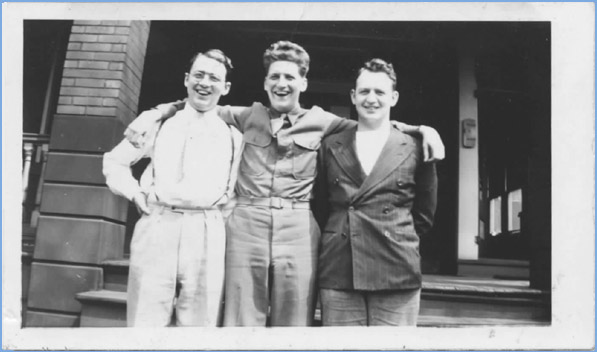 |
Same three stooges a few years later - you gotta look!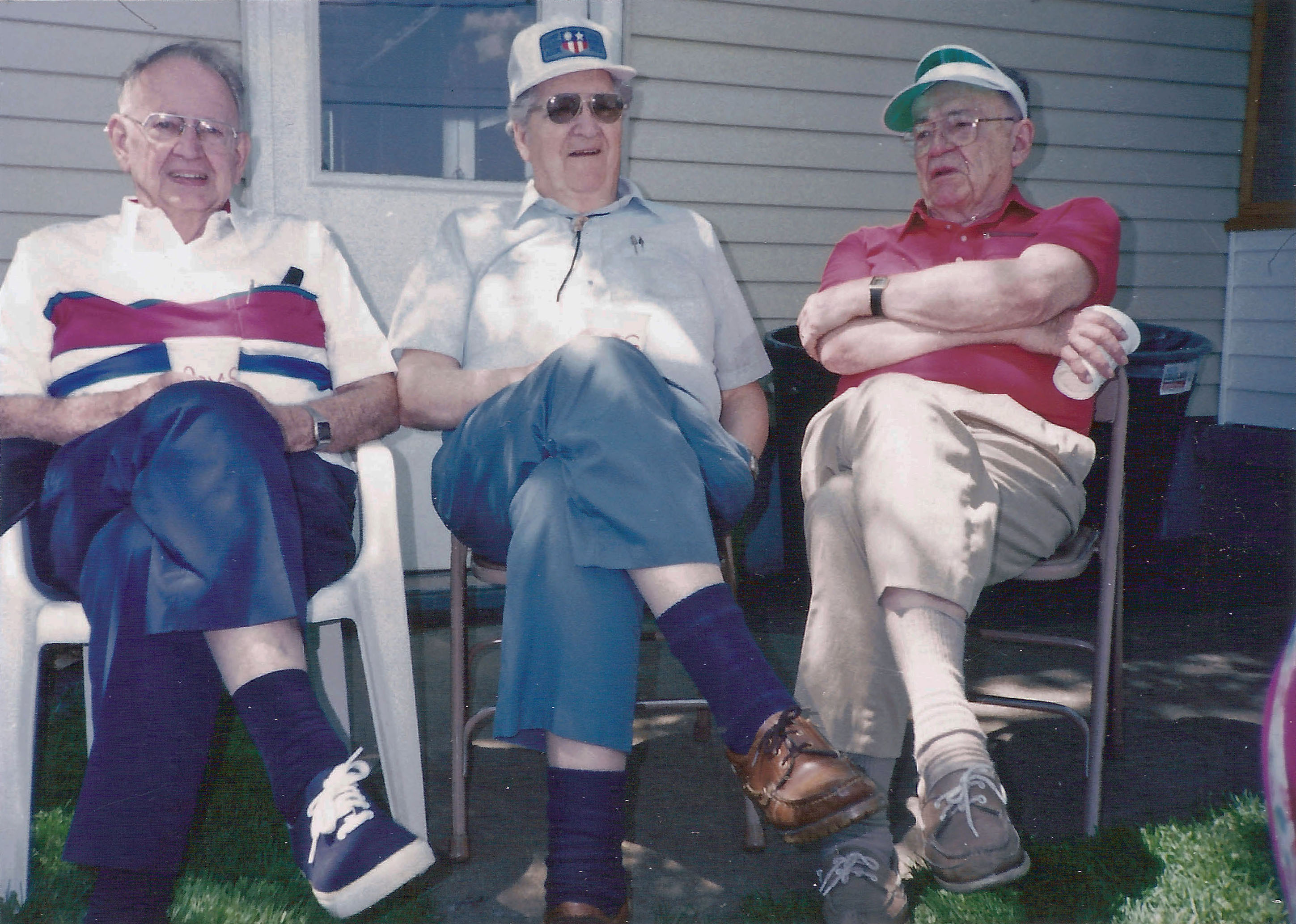 Click for larger version!
Click for larger version! |
HOME ON LEAVE with sister Cathie - Sept. 1944 |
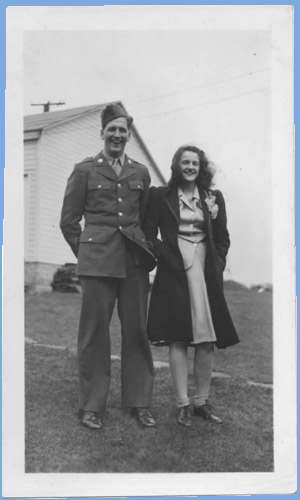 |
|
At the point of return/no return, one of the engines
quit. We kept on and made it safely to the verdant-hued island. The
engineer and I checked in to the enlisted transient quarters. When we
saw the puke-ridden mattresses that were on the bunks, we took our
bedding back to the quartermaster and told him he could shove it. We
slept in the back of our plane using olive drab wool blankets which we
had on board. We learned that the captured Nazi general who had
commanded forces at Metz was being billeted at the Bachelor Officer
Quarters. We were embittered by this. One thing that did elevate my spirits was watching Jinx Falkenberg, the model and movie star, play ping pong at the rec hall. I believe she was on her way to China to entertain the troops. |
|
One evening was spent in
partying when the engineer and I joined our pilot and co-pilot
surreptitiously at their quarters. The menu was limited to champagne
and peanuts! When the faulty engine was repaired, we flew east to
Marrakech, Morocco and then on to Tunis, Tunisia, staying overnight.
Sometime after arriving in Africa, we discovered that our plane had
been invaded by the ravenous rats of the Azorean Archipelago. They had
feasted on K-ration chocolate while ripping holes in my barracks bag
and underwear! Next day I was surprised to see foxholes and tank tracks
in the sands below as we headed to Cairo, Egypt. These battle signs
were still plainly evident a year and a half after the fighting had
ceased. Another overnight permitted me to see a USO show at Payne
Field. Leaving the Pyramids, we were soon over the Jordan River and the
Dead Sea. Angling south over Baghdad, Iraq, we landed in view of date
palms at Abadan, Iran. With gas tanks filled, our aircraft carried us
across the desolate-looking mountains to the port of Karachi, India. My
engineer and I went into town to get the 'feel' of this foreign land.
With the press of humanity (beggar children), we learned the word
"baksheesh" meant "give me money (or gift)". With equal astuteness, we
learned the answer was "Jao" which meant "beat it!". So much for
international understanding. On the next day, Christmas 1944, we traveled across the sub-continent of Mother India and made our final landing of the journey at Tezgaon airfield near Dacca, the capital of Bengal Province. |

THE C-54 SKYMASTERThis was my favorite aircraft in which I spent over 80% of my flying time.OVER THE HILLSI spent the next 9½ months logging 750 hours airborne making 56 round trips over The Hump and two round trips between Karachi and Calcutta. Since the operation was based on the use of airmen on an as-needed or as-available basis, crew members rotated continuously. I flew as radioman in 65 different planes with 50 different pilots. Most of our effort was to deliver aviation gasoline and other supplies from our home base of Kurmitola, 1345 AAF Base Unit, to various airfields in China.Note: Item from the Hump Express, Vol. 1, No. 5, published by the India China Division, Air Transport Command: ANOTHER RECORD ! 1345 BU, INDIA - A new base record was established here last week as planes of the 1345 hopped the Hump with more supplies, in less time, than ever before in the short history of this base. Lt. Col. Silas A. Morehouse, CO, in a brief statement commended air and ground crews for their tireless work and unceasing effort in making this achievement possible. Actual figures are not releasable, but the new record is almost double the previous mark. My personal log records such names as Luliang, Kunming, Chengtu, Hsinching, Kwanghan, Chengkung, Chanyi, Liuchow, Luhsien, and Shanghai. Stopovers in Burma were Bhamo, Kan and Myitkyina (where I got to swim in the Irriwaddy River). Destinations in India had names of Barrackpore, DumDum, Sylhet, Agra and Shillong. I visited the Edwin Brush family on a 3-day pass to Kharagpur, which was quite an enjoyable break in routine. Mrs. Brush was my mother's cousin. They were Baptist missionaries to India. Around camp, diversions were limited. We were housed four to a tent which was thankfully a British type. It was made of white canvas with a double roof and side flap. This design afforded a cooler home than the single-ply olive-drab U.S. issue. The floor of the tent was a raised earth platform covered in heavy-duty tarpaper. Beds were charpoys, wooden-framed with strung-rope springs(?). These were topped with thin cotton mattresses which provided minimum comfort. Thin bamboo poles were attached to the corner legs to provide support for the hanging of mosquito nets. Other furniture was a non-descript writing table and chair in the center. Outside we sat on empty bomb-fin crates and an Adirondack 'recliner' patched together from junked shipping boxes. A lone bare light bulb, of maybe 40 watts, hung over the table. When electricity failed, we used candles. __? ____?_____ Some fellows had pet monkeys which were mean and dirty. There was a pregnant goat that made her daily rounds, begging food. A few guys tried to dress up our surroundings by planting flowers or banana trees by their tents. My co-pilot had a vicious mongoose caged in his shelter. He also managed to latch on to a rebuilt British motorcycle ( a Triumph from Burma ?) which I got to drive a couple of times. I didn't ask him where he got the gasoline. I did attend chapel when I was free. One day my buddy and I sat in on the rape trial of a GI. I can't recall the outcome. Movies and letter-writing used up any free time when I wasn't flying, eating or sleeping. The Far East was really a fascinating area. Most of the native people I came into contact with ranged from merchants to lowly laborers. Hindus, Moslems and Buddhists composed the majorities. Among the native Indians were members of groups working to gain independence from England. Some believed that a Japanese victory would help bring this about. I recall that within an hour after we were advised to prepare for a gas raid drill, Tokyo Rose would broadcast from Japan, "Don't worry, boys, we're not going to gas you." On a couple of occasions during the dark of the moon, 'professional' native thieves would drift through our tents where we were sleeping. Unseen and unheard, they would lift articles and disappear into the night. Next morning, articles which could be identified as government issue, such as uniform items and sidearms, would be found left in surrounding fields. Manindra Kumar Sarkar was the "bearer", or house boy, whom we employed to maintain our domicile and provide us various personal services. He was a fairly short, muscular, dark-skinned Hindu fellow who was 20 years of age, the same as me. "Mani" was efficient as well as pleasant. Putting in maybe 10 to 12 hour days, he kept our beds made, our clothes taken to the laundry, and the tent clean and organized. We had noticed that Mani had what looked like a copper, spent .22 caliber ammo shell attached to his upper arm with red string. When we asked him what it was, his answer was 'medicine.' Curiosity impelled us to take the amulet from him (against his protests) and to begin dismantling the object. The end was sealed with wax which we removed. The contents of the capsule was found to be merely a folded and rolled paper. The paper was unfolded and spread out to reveal mysterious designs along with Bengali writing. As we performed this obvious desecration, Mani was trying to bury his head in one of the cots, wailing in surrender. With our encouragement added to his own curiosity, our good bearer finally looked at the paper. To his own astonishment, for he had never seen what he had carried on his arm since babyhood, he found a Hindu prayer or blessing. As we reconstituted this icon, we assured him that although the content was not medicine, prayer itself could well be more powerful in his life. So ended our journey into the mysticism of the East. On an early flight to China, I observed Chinese building or repairing the field with crushed rock. It was then I noted certain women in the work gangs walking in a stilted manner. Oh, yes, I recalled, those are the real-life examples of photographs I had seen in the National Geographic. Those were the ladies who had been subjected to having their feet bound since early childhood. Now in adulthood they walked on what amounted to peglegs. On one trip to an airfield in China, I somehow ended up in a single cubicle make-shift shower. It was one that had a small hand-filled tank mounted above a simple wooden frame. Pulling a chain, one could manage to get enough water spray to wash and rinse oneself. I was enjoying this outdoor ablution when I saw an old worklady hobbling by the open end of my edifice. We each took a transitory look of a nanosecond at each other and moved on with our labors. The following links will take you to several stories which maybe cover high and low points of my overseas tour of duty.
THE B-25 MITCHELL BOMBER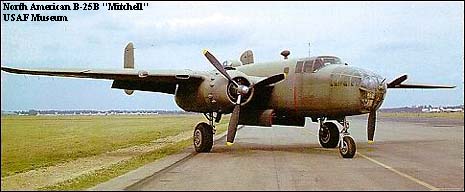 I took one flight in this noisy bird with a Colonel pilot. I was a
fifth wheel as the radio was inoperative the whole trip. From the air I
saw a beautiful white Burmese temple surrounded by seemingly solid
green jungle.
I took one flight in this noisy bird with a Colonel pilot. I was a
fifth wheel as the radio was inoperative the whole trip. From the air I
saw a beautiful white Burmese temple surrounded by seemingly solid
green jungle. |
|
THE C-47 SKYTRAIN |
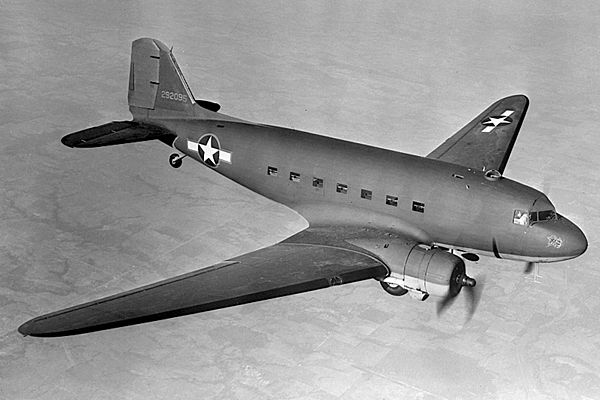 This plane was used mostly on "milk runs" to Calcutta for necessities
like whiskey. (Don't tell anyone.) I did make a hop to a beach-jungle
rest camp named George George. It was on the eastern shore of the Bay
of Bengal somewhere near Chittagong.
This plane was used mostly on "milk runs" to Calcutta for necessities
like whiskey. (Don't tell anyone.) I did make a hop to a beach-jungle
rest camp named George George. It was on the eastern shore of the Bay
of Bengal somewhere near Chittagong.
After I finished my flight duties in mid-October, time was spent waiting to be returned to the U.S.A. Every week the camp was assigned a new Commanding Officer. Each one got up before us at a confabulation and made the grand promise that he would be the last to leave when the camp was closed. Within a week, each one in turn hopped on a plane heading to the Zone of the Interior (home) To combat boredom, I signed up for a course in Spoken Spanish and attempted to complete my correspondence course in Algebra. Four of us teamed up to play Contract Bridge while tanning under the warm sun. We had a book on this card game by Goren (?) which was used to chastise anyone who goofed too badly. Time dragged until I boarded a Skymaster headed west for Karachi. From there we were trucked past dismal hovels of the lower castes out to Camp Malir in the Sind Desert. This base had been home for troops training to repel Rommel in North Africa. Now I lived in a concrete block barrack which was hot during daylight and which turned cold at night. This was another period of waiting (normal in military service) for a ship to float us home. I read books like "Forever Amber" and "Geography in Human Destiny". I carefully wound my way over winding roads in the ultra-dark nights to the movies. This true desert was so dry that in shaving outdoors, the face had to be wetted before each stroke of the razor. For Christmas. I attended the Catholic service at midnight. This Lutheran PK could not decipher the Latin words which were spoken but was nevertheless a worshipper. Maybe the prayers were rewarded, for notice came that our transport was due soon. [From the India-Burma Theater Roundup newspaper dated Dec. 27, 1945: The Karachi ships and their tentative shipping dates are: The Santa Rosa, Jan. 2; Gen. Greeley, 5th, and the Gen. Morton, last vessel scheduled to sail from Karachi as a troop carrier, Jan. 21. Transportation officers emphasized that all shipping dates are liable to change, principally because of bad weather delaying arrival of some of the vessels. They also announced that a last minute change in the shipping schedule is resulting in the Gen. Callan and the Gen. Stewart sailing to Seattle instead of New York.] *Note--Because of this change, I ended up circumnavigating the globe I packed up again and was trucked to the portside where I plodded up the gangplank burdened with heavy barracks bag. I put my possessions on my stretched canvas bunk in my allotted 6½'x2'x3' space below decks. Then I went up to the enlisted men's deck and made my acquaintance with the U.S.S. General E. Callan, my home for the next month. |
|
We watched the outline of the harbor
diminish as the ship's propellers pushed us out to sea. This event
brought on wistful memories mixed with hopeful anticipation. We were
finally on our way! Life aboard this troopship was not exactly fun but because of our ultimate destination, we were patiently longsuffering. Unimaginative meals were eaten while standing, although we did have Australian-mix ice cream once. After trying to work up a lather in a saltwater shower, I felt like I had bathed in Elmer's glue. To put in time, I read books and the ship's paper; tried to spot nurses and Wacs on the upper decks; listened to music, news and announcements from the loudspeakers; watched talent shows by fellow travelers; tried to make out shorelines and navigation lights miles away; tracked other ships that passed in the night (or day); and enjoyed the happy look of porpoises and flying fish which often accompanied us. |
|
The Callan trudges along at 17 knots,
covering about 400 miles in 24 hours. The itinerary went about like
this: in the Arabian Sea south along the west coast of India to Dondra
Head lighthouse; through the Straits of Malacca while glimpsing
Sumatra, Dutch East Indies on our starboard and the Malay Peninsula on
our port; into Singapore Roads for fresh water and fuel oil; then into
the South China Sea past Borneo and Sarawak toward the Sulu Sea; passed
the lighthouse of Tubba Ta Ha; weaved among the Phillipine Islands past
Mindanao; followed Great Circle Route north of Guam; slipped past
Diamond Point Head into a berth opposite Oahu, Hawaiian Islands; and
then the last lap which took us through Puget Sound to the welcoming
arms of Seattle. The signature song played constantly during our voyage
was "Sentimental Journey" and it sure had been one.
|
LAST LEGMuch as I liked Seattle, I eagerly boarded an eastbound train. The February landscape had a rather drab look but it was discounted as I viewed the peaceful countryside. The iron horse brought me to Camp Atterbury, Indiana for processing and discharge.As we got one last "orientation" at the G.I. theater, some officer asked the assemblage, "Do you want to stay in?" Answer: a thunderous "NO!" Second question, "Do you want to sign up for the reserves?" Second reply: a thunderous "NO" Actually, I did sign up in the inactive reserves. |
|
My discharge paper itemized the following: Battles and Campaigns- China; Central Burma; India-Burma Decorations and Citations- American Theater ribbon; Asiatic-Pacific Theater ribbon w/3 bronze stars; Air Medal w/1 cluster bronze; Distinguished Unit Badge; Victory Medal World War II: Good Conduct Medal Continental Service- 1 year, 7 months, 2 days Foreign Service- 1 year, 3 months, 3 days Highest Grade Held- PFC Lapel button (ruptured duck) issued Unnoticed by me at that time was the complete omission of any reference to the Good Conduct Medal! [Upon my request made 50 years later for all items due me, the Air Force did send me a GCM.] To complete my adventure, I traveled by train to the majestic Pennsylvania Station in Pittsburgh, took a yellow cab home, and arrived to a joyous reunion. |
| previous page | home | next page |